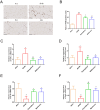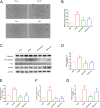Kaempferol alleviates adipose tissue inflammation and insulin resistance in db/db mice by inhibiting the STING/NLRP3 signaling pathway
- PMID: 38466634
- PMCID: PMC11046349
- DOI: 10.1530/EC-23-0379
Kaempferol alleviates adipose tissue inflammation and insulin resistance in db/db mice by inhibiting the STING/NLRP3 signaling pathway
Abstract
Chronic inflammation induced by obesity plays a crucial role in the pathogenesis of insulin resistance. The infiltration of macrophages into adipose tissues contributes to adipose tissue inflammation and insulin resistance. Kaempferol, a flavonoid present in various vegetables and fruits, has been shown to possess remarkable anti-inflammatory properties. In this study, we used leptin receptor-deficient obese mice (db/db) as an insulin-resistant model and investigated the effects of kaempferol treatment on obesity-induced insulin resistance. Our findings revealed that the administration of kaempferol (50 mg/kg/day, for 6 weeks) significantly reduced body weight, fat mass, and adipocyte size. Moreover, it effectively ameliorated abnormal glucose tolerance and insulin resistance in db/db mice. In the adipose tissue of obese mice treated with kaempferol, we observed a reduction in macrophage infiltration and a downregulation of mRNA expression of M1 marker genes TNF-α and IL-1β, accompanied by an upregulation of Arg1 and IL-10 mRNA expression. Additionally, kaempferol treatment significantly inhibited the STING/NLRP3 signaling pathway in adipose tissue. In vitro experiments, we further discovered that kaempferol treatment suppressed LPS-induced inflammation through the activation of NLRP3/caspase 1 signaling in RAW 264.7 macrophages. Our results suggest that kaempferol may effectively alleviate inflammation and insulin resistance in the adipose tissue of db/db mice by modulating the STING/NLRP3 signaling pathway.
Keywords: STING/NLRP3; adipose tissue inflammation; db/db mice; insulin resistance; kaempferol; obesity.
Conflict of interest statement
‘The authors declare that there is no conflict of interest that could be perceived as prejudicing the impartiality of the study reported.
Figures





Similar articles
-
Bilirubin increases insulin sensitivity in leptin-receptor deficient and diet-induced obese mice through suppression of ER stress and chronic inflammation.Endocrinology. 2014 Mar;155(3):818-28. doi: 10.1210/en.2013-1667. Epub 2014 Jan 1. Endocrinology. 2014. PMID: 24424052 Free PMC article.
-
Omentin-1 attenuates adipose tissue inflammation via restoration of TXNIP/NLRP3 signaling in high-fat diet-induced obese mice.Fundam Clin Pharmacol. 2020 Dec;34(6):721-735. doi: 10.1111/fcp.12575. Epub 2020 Jun 21. Fundam Clin Pharmacol. 2020. PMID: 32479684
-
Cilostazol ameliorates systemic insulin resistance in diabetic db/db mice by suppressing chronic inflammation in adipose tissue via modulation of both adipocyte and macrophage functions.Eur J Pharmacol. 2013 May 5;707(1-3):120-9. doi: 10.1016/j.ejphar.2013.03.016. Epub 2013 Mar 22. Eur J Pharmacol. 2013. PMID: 23528355
-
Adipocyte-Macrophage Cross-Talk in Obesity.Adv Exp Med Biol. 2017;960:327-343. doi: 10.1007/978-3-319-48382-5_14. Adv Exp Med Biol. 2017. PMID: 28585206 Review.
-
Recent advances in the relationship between obesity, inflammation, and insulin resistance.Eur Cytokine Netw. 2006 Mar;17(1):4-12. Eur Cytokine Netw. 2006. PMID: 16613757 Review.
Cited by
-
Therapeutic Potential of Myricitrin in a db/db Mouse Model of Type 2 Diabetes.Molecules. 2025 Mar 25;30(7):1460. doi: 10.3390/molecules30071460. Molecules. 2025. PMID: 40286055 Free PMC article.
-
Beneficial effects of Elaeagnus rhamnoides (L.) A. Nelson and its most abundant flavonoids on the main mechanisms related to diabetic bone disease.Pharm Biol. 2025 Dec;63(1):460-489. doi: 10.1080/13880209.2025.2523392. Epub 2025 Jul 3. Pharm Biol. 2025. PMID: 40607760 Free PMC article. Review.
References
-
- Navarro-Ruiz MDC Lopez-Alcala J Diaz-Ruiz A Moral SDD Tercero-Alcazar C Nieto-Calonge A Lopez-Miranda J Tinahones FJ Malagon MM & Guzman-Ruiz R. Understanding the adipose tissue acetylome in obesity and insulin resistance. Translational Research 202224615–32. (10.1016/j.trsl.2022.02.008) - DOI - PubMed
-
- Sardi C Martini E Mello T Camelliti S Sfondrini L Marcucci F Kallikourdis M Sommariva M & Rumio C. Effect of acetylsalicylic acid on inflamed adipose tissue. Insulin resistance and hepatic steatosis in a mouse model of diet-induced obesity. Life Sciences 2021264118618. (10.1016/j.lfs.2020.118618) - DOI - PubMed
-
- Xiong XQ, Geng Z, Zhou B, Zhang F, Han Y, Zhou YB, Wang JJ, Gao XY, Chen Q, Li YH, et al.FNDC5 attenuates adipose tissue inflammation and insulin resistance via AMPK-mediated macrophage polarization in obesity. Metabolism: Clinical and Experimental 20188331–41. (10.1016/j.metabol.2018.01.013) - DOI - PubMed
LinkOut - more resources
Full Text Sources
Research Materials
Miscellaneous

